Hawks & Eagles
Admired for their strength and hunting prowess, renowned for their keen eyesight, emblazoned on flags and national shields, the hawks and eagles are recognized worldwide. Most birds of prey that hunt by day belong to this family — more than 240 species, ranging in size from huge eagles to speedy little hawks no bigger than robins. Several kinds are familiar sights over the Sonoran Desert.
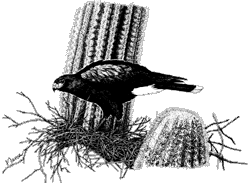
Harris’s Hawk
Red-tailed Hawk and Cooper’s Hawk, widespread over North America, are common in the desert year-round. The red-tail, one of the typical soaring buteo hawks (buteos are larger hawks with broad, rounded wings and short, broad tails), is far more often seen, as it perches in the open or circles overhead, watching for rodents and other prey. Cooper’s Hawk is typical of the accipiter group; it is a long-tailed, short-winged bird that seldom soars. Hunting near dense cover, relying on speed and surprise, Cooper’s hawk takes many birds as well as rodents.
Seen less often here are eagles and Ospreys. The Osprey is a hawk that plunges feet-first to catch fish; in the southwest it visits the larger bodies of water, but occasionally a migrant is seen flying over the open desert. Bald Eagles are also seen mostly close to water; a few pairs nest along wilder rivers in the Sonoran Desert. Golden Eagles, by contrast, are often in very dry country, where these huge predators take animals as large as jackrabbits.
Birds of prey are generally solitary, but there are exceptions. Harris’s Hawk, a sharply patterned raptor of warm climates, lives in small groups. Three or more adults often care for the young in a single nest, and two or three may hunt cooperatively, actively harrying prey animals out into the open. A classic desert sight involves three or four Harris’s Hawks perched on adjacent arms of the same giant saguaro.
—Kenn Kaufman
Sonoran Desert species:
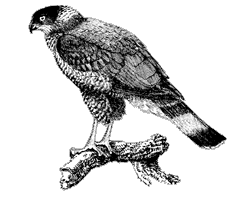
Cooper’s Hawk
Osprey (Pandion haliaetus)
Bald Eagle (Haliaeetus leucocephalus)
Cooper’s Hawk (Accipiter cooperii)
Red-tailed Hawk (Buteo jamaicensis)
Golden Eagle (Aquila chrysaetos)
Harris’s Hawk (Parabuteo unicinctus)
Order: Accipitriformes
Family: Accipitridae
Subfamily: Pandioninae (Osprey)
Spanish Names: gavilan pescador (Osprey), aquila calva (Bald Eagle), esmerejon de Cooper (Cooper’s Hawk), aquilla parda (Red-tailed Hawk), águila real (Golden Eagle), aguilla cinchada (Harris’s Hawk).
Distinguishing Features
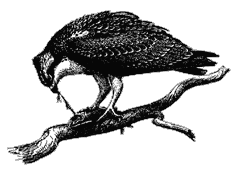
Osprey
- Osprey
- Snowy white underparts and dark brown above; head is white with a dark brown eye stripe. In flight the long, narrow wings have dark wrist patches and the white belly is obvious. Females are similar to males but usually show a band of brown streaks across the chest.
- Bald Eagle
- A very large brown raptor with a white head and tail; bill is yellow; a larger head and shorter tail than the Golden Eagle; young resemble the adults but are solid dark brown at first, developing the white head and tail over a period of several years.
- Cooper’s Hawk
- Medium-sized accipiter with a long tail rounded at the tip and short, round wings; adults are blue-gray above, and narrowly barred below with reddish-brown and white; young are more brown with streaked underparts.
- Golden Eagle
- A very large brown raptor with a golden head and neck; young show white patches in the wings and a white base to the black tail. Golden Eagles soar with their wings slightly raised.
- Red-tailed Hawk
- A very common hawk with a variety of plumages; brown above with broad, round wings. On adults the upperside of the tail is typically reddish-brown, and this color usually shows through from the underside as well. Some adults have a belly band of dark brown streaking with white underparts. Red-tailed Hawks in the Southwest usually have light underparts and lack a belly band; other color morphs may be mostly blackish, dark brown, or cinnamon-brown below. The young have gray-brown tails with black bands.
- Harris’s Hawk
- Dark brown with chestnut shoulder patches, leg feathering and wing linings; tail is long and black with white at the base and tip; young are lightly streaked below with brown. Hear the sounds of a Harris Hawk
Habitat
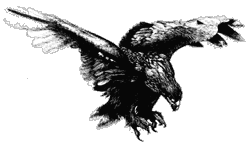
Golden Eagle
Ospreys and Bald Eagles are found near coastal areas, rivers, and lakes. Ospreys are less common inland. Golden Eagles can be found in mountain habitats, open country, and desert. Cooper’s Hawks occur in desert, woodlands, deciduous forests, and riparian areas. Red-tailed Hawks are found in a variety of habitats such as desert, woodlands, plains, riparian, and open areas. Harris’s Hawks occur in mesquite and saguaro habitats, semi-arid woodlands, and scrub.
Life History
Ospreys are fish hawks. They plunge and dive with feet first into the water to catch fish. The fish is taken to a perch or nest to be eaten. There are scales with spines on the toes for grasping fish. Ospreys are the only raptors whose front talons turn backwards. Ospreys also eat frogs, turtles, rodents, and occasionally birds.
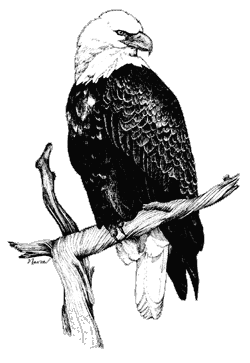
Bald Eagle
Bald Eagles prey on fish too. They will also feed on small mammals, waterfowl, seabirds, and carrion. Bald Eagles compete with Ospreys for food. Loss of habitat and the use of pesticides have affected Bald Eagles. In recent years the Arizona population has been increasing. They are still on the endangered list in our area, however.
Golden Eagles prey upon rabbits, small mammals and carrion. Pair bonds are long-term. Nests are large and bulky. The male feeds the female during incubation and chick rearing; the larger nestling usually kills the smaller. Territories are usually occupied all year.
Cooper’s Hawks, members of the accipiter group, fly with rapid, shallow wingbeats. They overtake their prey swiftly and often through dense woods or shrubs. They feed mostly on birds and some small mammals.
Red-tailed Hawks are the most common and widespread raptors in North America. They prey mostly on rodents and are often seen perched on telephone poles watching for prey. Females often return to the same nesting territory. Red-tailed Hawk populations are stable and increasing in some areas.
Harris’s Hawks are neotropical raptors that prey upon rabbits, rodents, snakes, lizards, and birds. These hawks are social and hunt in family groups. Most social groups consist of a pair and several nonbreeding helpers who assist in feeding the nestlings and defending the nest. This cooperative behavior is also used to flush and catch prey that is hiding in cover. Large family groups are observed during autumn and winter.